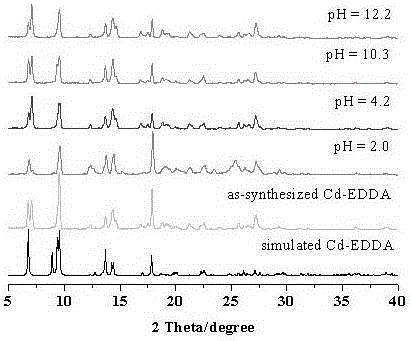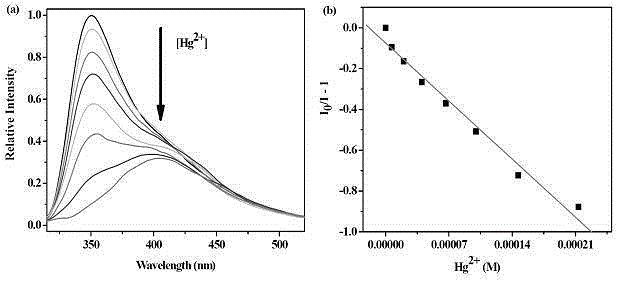Metal-organic framework material for detecting mercury ions on basis of ratio fluorescence
An organic framework, ratiometric fluorescence technology, applied in luminescent materials, fluorescence/phosphorescence, material excitation analysis, etc., can solve the problems of limited probe structure design and synthesis, mercury ion probe urgent, and unfavorable widespread promotion and research, etc. The effect of easy large-scale preparation, low price and easy preparation
- Summary
- Abstract
- Description
- Claims
- Application Information
AI Technical Summary
Problems solved by technology
Method used
Image
Examples
Embodiment 1
[0031] Example 1 (Synthesis of organic linker ligands)
[0032] Weigh 2.1g of dimethyl 5-hydroxyisophthalate and 3.3g of anhydrous potassium carbonate in a flask, add 40mL of acetonitrile, stir for a few minutes, slowly add 1.0g of 1,2-dibromoethane to the above system, and keep the temperature 80°C, react for 24 hours. Suction filtration, rotary evaporation, extraction with water and dichloromethane, drying with anhydrous sodium sulfate, rotary evaporation to obtain 5,5'-(ethane-1,2-disubstituted dioxo)diisophthalic acid di methyl ester.
[0033] Weigh 2.39g of 5,5'-(ethane-1,2-disubstituted dioxo)dimethyl diisophthalate and 0.65g of sodium hydroxide in a single-necked bottle, add 40mL of ethanol / water (v / v=4 / 1) mixed solvents, kept at a constant temperature of 80°C, and reacted for 4 hours under stirring. The above reaction solution was rotary evaporated, acidified with dilute hydrochloric acid, and washed with water after suction filtration to obtain a colorless solid...
Embodiment 2
[0034] Example 2 (Synthesis of Metal-Organic Frameworks)
[0035] Weigh 3.9 mg of 5,5'-(ethane-1,2-disubstituted dioxo)diisophthalic acid (H 4 EDDA ) (0.01mmol), 4.2mgCd(ClO 4 ) 2 ·6H 2 O (0.01mmol) in a 10mL glass sample vial, add 7mL of water as a solvent, then place the glass sample vial in a hydrothermal synthesis reaction kettle, and then place the hydrothermal synthesis reaction kettle in an electric blast drying oven at constant temperature 120°C, react for three days. After the reaction is over, cool to obtain colorless blocky crystals, filter, wash, and dry, which is the metal-organic framework material Cd– EDDA , whose three-dimensional structure is shown in figure 1 As shown, the yield: 80%. Cd 1.5 (C 18 h 10 o10 )?(H 2 O) 3 :C35.50;H2.65;O34.16.Found:C,35.55;H,2.45;N,34.21.
Embodiment 3
[0036] Example 3 (Material Stability Test)
[0037] Take by weighing 5 parts of material Cd in embodiment 2- EDDA , were added to aqueous solutions with pH values of 2.0, 4.2, 7.0, 10.3, and 12.2, stirred for 24 hours, filtered, and tested for PXRD after vacuum drying at room temperature. The test results are shown in figure 2 shown.
PUM
 Login to View More
Login to View More Abstract
Description
Claims
Application Information
 Login to View More
Login to View More - R&D
- Intellectual Property
- Life Sciences
- Materials
- Tech Scout
- Unparalleled Data Quality
- Higher Quality Content
- 60% Fewer Hallucinations
Browse by: Latest US Patents, China's latest patents, Technical Efficacy Thesaurus, Application Domain, Technology Topic, Popular Technical Reports.
© 2025 PatSnap. All rights reserved.Legal|Privacy policy|Modern Slavery Act Transparency Statement|Sitemap|About US| Contact US: help@patsnap.com



